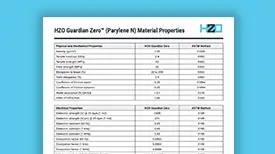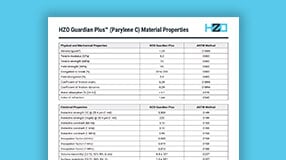Parylene Conformal Coatings - Parylene Conformality Explained

Parylene (p-polyxylylene) conformal coatings are unique due to their capacity to be polymerized and deposited by the chemical vapor deposition (CVD) method onto surfaces near room temperature. As a result of this process, pinhole-free, high-purity, extremely thin coatings are formed out of dimer materials.
Regarding conforming to complex or unusual surfaces, Parylene is one of the best polymer coatings for moisture resistance. This attribute and the fact that Parylene is a stable chemical compound that creates an excellent barrier make it the optimal choice where resilient electronic products are a mandate. But why is Parylene coating conformal?
Download HZO’s Parylene datasheet to learn more about Parylene’s properties
Why is Parylene Coating Conformal?
Liquid coatings with application methods such as dipping, brushing, or spraying may cause the coatings to exhibit meniscus forces or pull away from edges, which does not occur with Paylene deposition. With CVD, the coating penetrates around and beneath closely spaced components with consistent, uniform buildup, allowing for substantial physical and electrical protection with a substantially thinner layer than conventional coatings.
Parylene Deposition Process
Thus, the Parylene coating process explains why Parylene is so conformal. You can read an in-depth description of the CVD process versus PECVD in our blog on the subject; below are some general benefits of CVD:
Download a visual explanation of the process
- CVD produces coatings with complete coverage even around and beneath closely spaced chips and wires.
- CVD deposits Parylene molecule by molecule onto substrates with precision and control.
- The Parylene deposition process requires no catalyst, hardener, or heat curing.
- Polymerization does not release harmful by-products, as with other conformal coatings.

When Parylene polymers are deposited from the vapor phase with the CVD process, all sides of a component are impinged by the gaseous monomer and uniformly coated. This feature of the process is responsible for why Parylene coating is conformal.
Importance of Conformality and Uniformity
Truly conformal coverage occurs when a film precisely follows the coated component’s geometry. Conformality allows for the optimization of surface properties regardless of the shape of the part and ensures that microdevice properties such as conductance do not vary due to significant variations in thickness. Uniform thickness is critical to prevent proper reinforcement against degradation and wear.
Parylene Conformality Compared to Liquid Coatings

Along with performance concerns, achieving uniformity improves production factors such as yield rates and repeatability. With the chemical vapor deposition process, engineers have confidence that there will not be thickness fluctuations from product to product and that specs are being met. By ensuring optimum coating deposition performance is met, you can lower your total cost of ownership by keeping your repeatability and yield on target.
Parylene Conformal Coating Service with HZO
However, although a process may achieve repeatable, uniform thickness distributions, this does not mean it is viable for your company – uptime and upfront costs must also be considered. Parylene has traditionally only been used for mission-critical applications such as medical products. HZO, a turnkey CVD process provider, has made Parylene and its application feasible for most industries for years. Our engineers have crafted capital coating equipment that addresses upfront cost concerns and makes Parylene scalable. If you are interested in the powerful barrier properties of Parylene films and the benefits of its vacuum deposition process, reach out today to speak to one of our engineers.
An Overview of Our Parylene Coating Equipment
What is Parylene? Industry Use Cases, Types, Properties
Parylene Coating Removal - Methods & Best Practices for Each
Mallory is a veteran writer with over a decade of writing experience and has spent over five years at HZO learning about coating technology from the best minds in the industry. Professionally, Mallory is especially interested in the process of problem-solving and watching how the engineering team develops solutions that ensure business requirements are met. Over her years at HZO, Mallory's writing has been cited in industry whitepapers, including "Parabolic Model for Optimum Dry Film Thickness (DFT) of Corrosion Protective Coatings" and "Universal Approach to Integrating Reduced Graphene Oxide into Polymer Electronics." All of Mallory’s blogs are reviewed for accuracy before publication.
Additional Resources

Learn About Parylene Properties With Our Resource Page

Learn How To Incorporate Conformal Coating Into Your Manufacturing Process

Learn About the Thin Film Coating Properties and Processes In Our Webinar

Learn How to Bring Parylene Deposition In-House





















